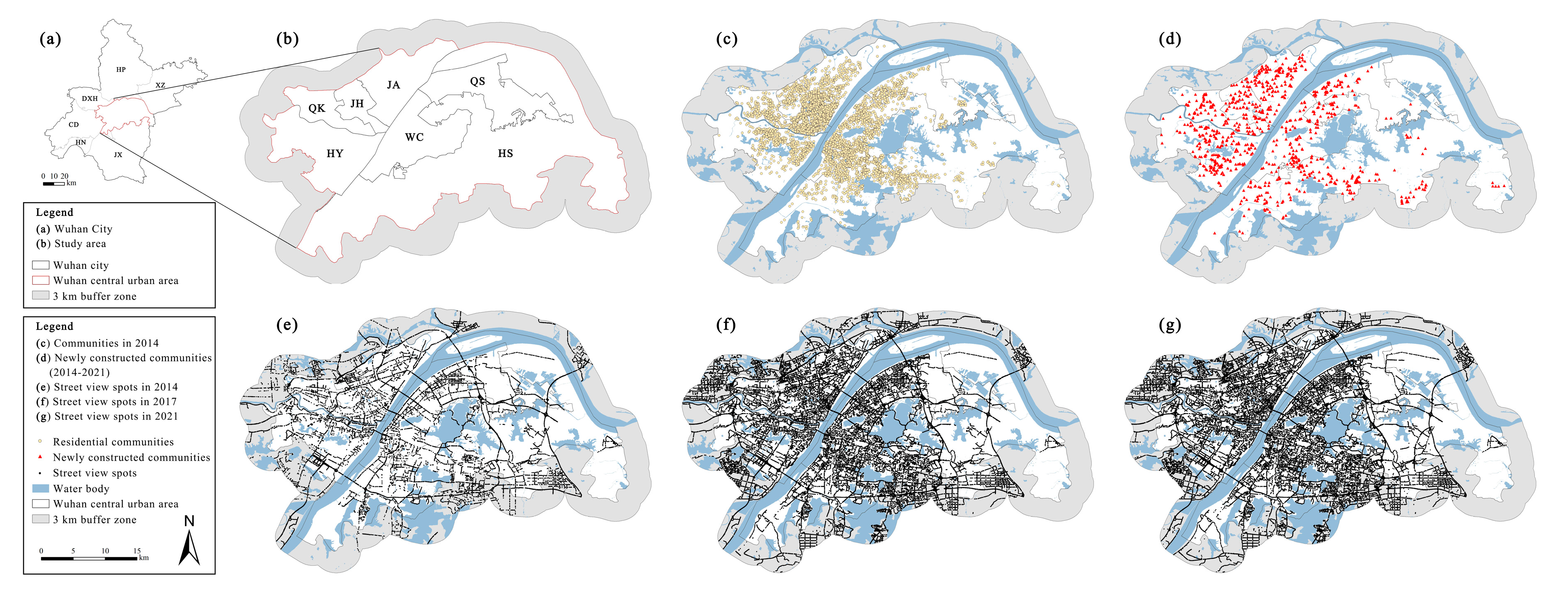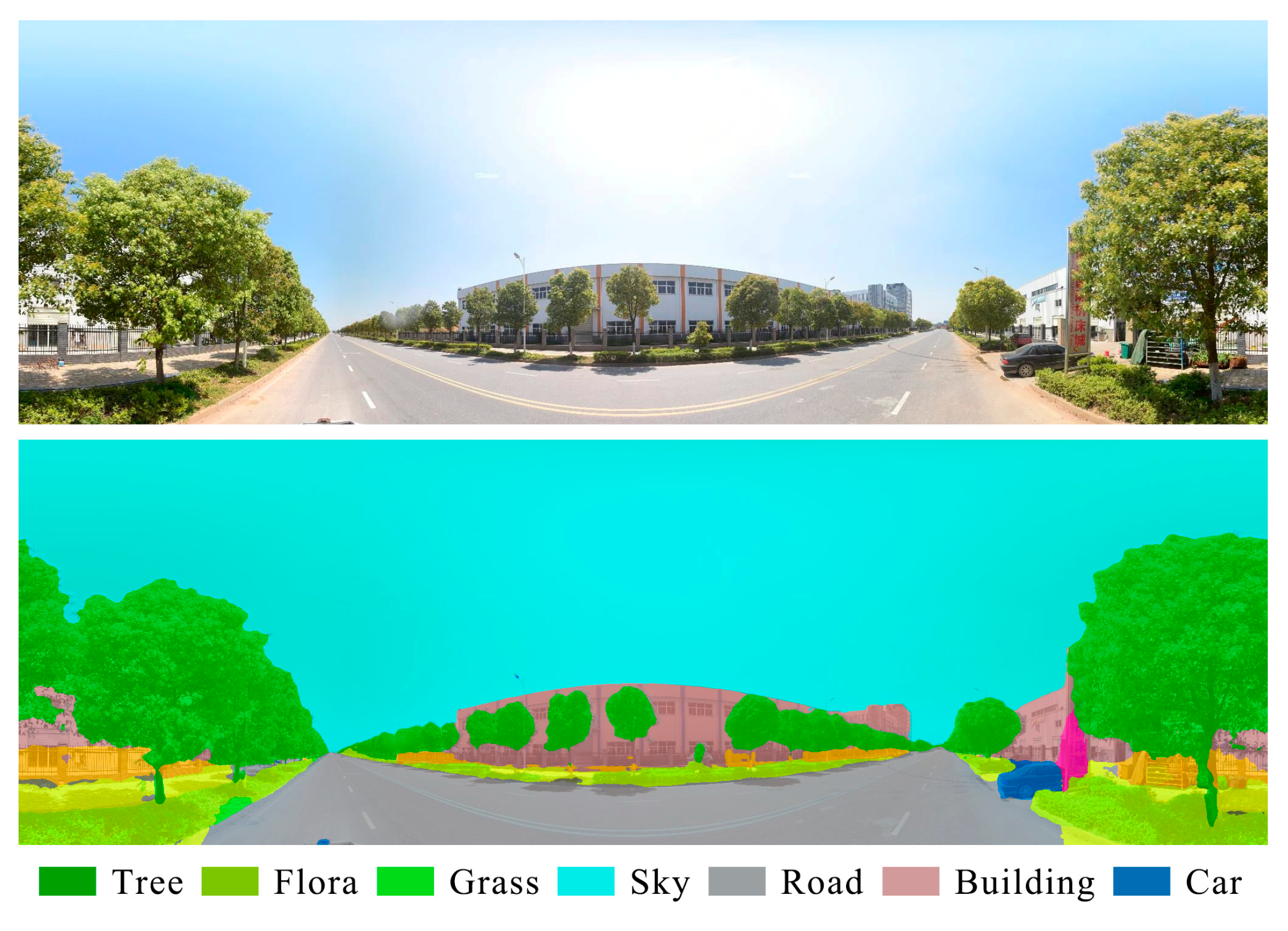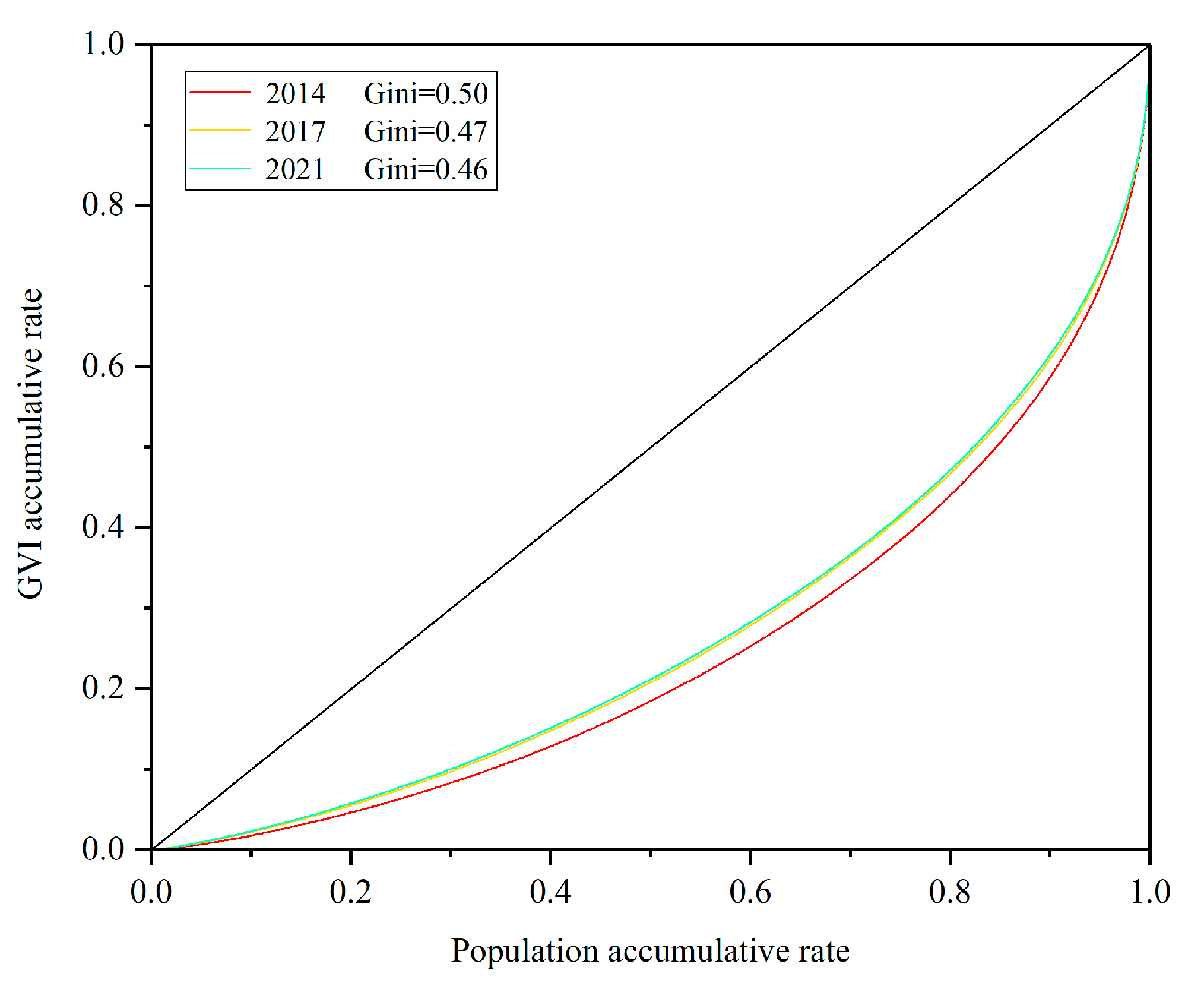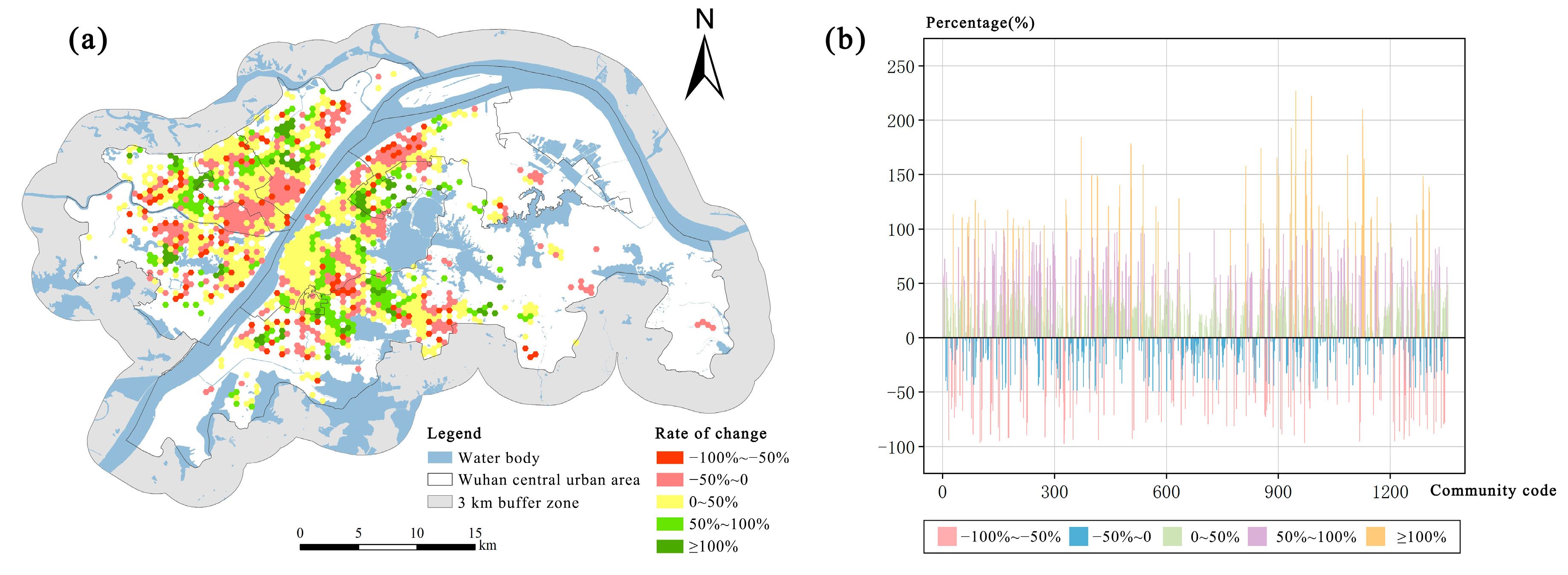Identification of Inequities in Green Visibility and Ways to Increase Greenery in Neighborhoods: A Case Study of Wuhan, China
Abstract
1. Introduction
- To evaluate the level and spatio-temporal patterns of street-level greening around residential communities from 2014 to 2021;
- To assess the spatial equity of green visibility in residential communities across different regions from 2014 to 2021, revealing the dynamic characteristics of equity changes;
- To provide improvement strategies for mitigating inequities and building a green, equitable city based on an in-depth analysis of changes in visibility equity.
2. Materials and Method Methodology
2.1. Research Framework
2.2. Case Study Area
2.3. Data Sources and Processing
2.3.1. Street View Images
2.3.2. Residential Community Data
2.4. Green Visibility Assessment with Green View Index (GVI)
2.5. Evaluation Methods for the Spatial Equity of Green Visibility
2.5.1. Gini Coefficient and Lorenz Curve
2.5.2. Location Quotient
3. Results
3.1. Changes in Residential Population and Green Visibility
3.2. Equity Changes Based on the Gini Coefficient and the Lorenz Curve
3.3. Equity Changes Based on the Location Quotient
3.3.1. Spatial Characteristics of the Location Quotient
3.3.2. Changes in Location Quotient
4. Discussion
4.1. Reasons for Changes in Green Visibility Equity
4.2. Relevant Improvements for Urban Greening Strategies
4.3. Limitations
5. Conclusions
Author Contributions
Funding
Institutional Review Board Statement
Informed Consent Statement
Data Availability Statement
Conflicts of Interest
References
- Jabbar, M.; Yusoff, M.M.; Shafie, A. Assessing the Role of Urban Green Spaces for Human Well-Being: A Systematic Review. GeoJournal 2022, 87, 4405–4423. [Google Scholar] [CrossRef] [PubMed]
- Kabisch, N.; Haase, D. Green Justice or Just Green? Provision of Urban Green Spaces in Berlin, Germany. Landsc. Urban Plan. 2014, 122, 129–139. [Google Scholar] [CrossRef]
- Jim, C.Y.; Chen, W.Y. Assessing the Ecosystem Service of Air Pollutant Removal by Urban Trees in Guangzhou (China). J. Environ. Manag. 2008, 88, 665–676. [Google Scholar] [CrossRef] [PubMed]
- Margaritis, E.; Kang, J. Relationship between Green Space-Related Morphology and Noise Pollution. Ecol. Indic. 2017, 72, 921–933. [Google Scholar] [CrossRef]
- Yao, L.; Li, T.; Xu, M.; Xu, Y. How the Landscape Features of Urban Green Space Impact Seasonal Land Surface Temperatures at a City-Block-Scale: An Urban Heat Island Study in Beijing, China. Urban For. Urban Green. 2020, 52, 126704. [Google Scholar] [CrossRef]
- Zhou, S.; Diao, H.; Wang, J.; Jia, W.; Xu, H.; Xu, X.; Wang, M.; Sun, C.; Qiao, R.; Wu, Z. Multi-Stage Optimization Framework for Synergetic Grey-Green Infrastructure in Response to Long-Term Climate Variability Based on Shared Socio-Economic Pathways. Water Res. 2025, 274, 123091. [Google Scholar] [CrossRef]
- Kong, F.; Yin, H.; Nakagoshi, N. Using GIS and Landscape Metrics in the Hedonic Price Modeling of the Amenity Value of Urban Green Space: A Case Study in Jinan City, China. Landsc. Urban Plan. 2007, 79, 240–252. [Google Scholar] [CrossRef]
- Liu, Y.; Wang, R.; Lu, Y.; Li, Z.; Chen, H.; Cao, M.; Zhang, Y.; Song, Y. Natural Outdoor Environment, Neighbourhood Social Cohesion and Mental Health: Using Multilevel Structural Equation Modelling, Streetscape and Remote-Sensing Metrics. Urban For. Urban Green. 2020, 48, 126576. [Google Scholar] [CrossRef]
- Nesbitt, L.; Meitner, M.J.; Girling, C.; Sheppard, S.R.J.; Lu, Y. Who Has Access to Urban Vegetation? A Spatial Analysis of Distributional Green Equity in 10 US Cities. Landsc. Urban Plan. 2019, 181, 51–79. [Google Scholar] [CrossRef]
- Zhang, J.; Cheng, Y.; Li, H.; Wan, Y.; Zhao, B. Deciphering the Changes in Residential Exposure to Green Spaces: The Case of a Rapidly Urbanizing Metropolitan Region. Build. Environ. 2021, 188, 107508. [Google Scholar] [CrossRef]
- Robinson, J.M.; Mavoa, S.; Robinson, K.; Brindley, P. Urban Centre Green Metrics in Great Britain: A Geospatial and Socioecological Study. PLoS ONE 2022, 17, e0276962. [Google Scholar] [CrossRef] [PubMed]
- Rutt, R.L.; Gulsrud, N.M. Green Justice in the City: A New Agenda for Urban Green Space Research in Europe. Urban For. Urban Green. 2016, 19, 123–127. [Google Scholar] [CrossRef]
- Li, X.; Zhang, C.; Li, W.; Kuzovkina, Y.A. Environmental Inequities in Terms of Different Types of Urban Greenery in Hartford, Connecticut. Urban For. Urban Green. 2016, 18, 163–172. [Google Scholar] [CrossRef]
- Zhang, Y.; Wu, Q.; Wu, L.; Li, Y. Measuring Community Green Inequity: A Fine-Scale Assessment of Beijing Urban Area. Land 2021, 10, 1197. [Google Scholar] [CrossRef]
- Gascon, M.; Cirach, M.; Martínez, D.; Dadvand, P.; Valentín, A.; Plasència, A.; Nieuwenhuijsen, M.J. Normalized Difference Vegetation Index (NDVI) as a Marker of Surrounding Greenness in Epidemiological Studies: The Case of Barcelona City. Urban For. Urban Green. 2016, 19, 88–94. [Google Scholar] [CrossRef]
- Leng, S.; Sun, R.; Yang, X.; Chen, L. Global Inequities in Population Exposure to Urban Greenspaces Increased amidst Tree and Nontree Vegetation Cover Expansion. Commun. Earth Environ. 2023, 4, 464. [Google Scholar] [CrossRef]
- Hong, Z.; Xu, W.; Liu, Y.; Wang, L.; Ou, G.; Lu, N.; Dai, Q. Retrieval of Three-Dimensional Green Volume in Urban Green Space from Multi-Source Remote Sensing Data. Remote Sens. 2023, 15, 5364. [Google Scholar] [CrossRef]
- Wang, X.; Meng, Q.; Liu, X.; Allam, M.; Zhang, L.; Hu, X.; Bi, Y.; Jancsó, T. Evaluation of Fairness of Urban Park Green Space Based on an Improved Supply Model of Green Space: A Case Study of Beijing Central City. Remote Sens. 2022, 15, 244. [Google Scholar] [CrossRef]
- Williams, T.G.; Logan, T.M.; Zuo, C.T.; Liberman, K.D.; Guikema, S.D. Parks and Safety: A Comparative Study of Green Space Access and Inequity in Five US Cities. Landsc. Urban Plan. 2020, 201, 103841. [Google Scholar] [CrossRef]
- Zhang, S.; Yu, P.; Chen, Y.; Jing, Y.; Zeng, F. Accessibility of Park Green Space in Wuhan, China: Implications for Spatial Equity in the Post-COVID-19 Era. Int. J. Environ. Res. Public Health 2022, 19, 5440. [Google Scholar] [CrossRef]
- Jiang, B.; Deal, B.; Pan, H.; Larsen, L.; Hsieh, C.-H.; Chang, C.-Y.; Sullivan, W.C. Remotely-Sensed Imagery vs. Eye-Level Photography: Evaluating Associations among Measurements of Tree Cover Density. Landsc. Urban Plan. 2017, 157, 270–281. [Google Scholar] [CrossRef]
- Sánchez, I.A.V.; Labib, S.M. Accessing Eye-Level Greenness Visibility from Open-Source Street View Images: A Methodological Development and Implementation in Multi-City and Multi-Country Contexts. Sustain. Cities Soc. 2024, 103, 105262. [Google Scholar] [CrossRef]
- Biljecki, F.; Ito, K. Street View Imagery in Urban Analytics and GIS: A Review. Landsc. Urban Plan. 2021, 215, 104217. [Google Scholar] [CrossRef]
- Helbich, M.; Yao, Y.; Liu, Y.; Zhang, J.; Liu, P.; Wang, R. Using Deep Learning to Examine Street View Green and Blue Spaces and Their Associations with Geriatric Depression in Beijing, China. Environ. Int. 2019, 126, 107–117. [Google Scholar] [CrossRef]
- Lu, Y. The Association of Urban Greenness and Walking Behavior: Using Google Street View and Deep Learning Techniques to Estimate Residents’ Exposure to Urban Greenness. Int. J. Environ. Res. Public Health 2018, 15, 1576. [Google Scholar] [CrossRef]
- Wang, R.; Browning, M.H.E.M.; Qin, X.; He, J.; Wu, W.; Yao, Y.; Liu, Y. Visible Green Space Predicts Emotion: Evidence from Social Media and Street View Data. Appl. Geogr. 2022, 148, 102803. [Google Scholar] [CrossRef]
- Yang, L.; Yang, H.; Yu, B.; Lu, Y.; Cui, J.; Lin, D. Exploring Non-Linear and Synergistic Effects of Green Spaces on Active Travel Using Crowdsourced Data and Interpretable Machine Learning. Travel Behav. Soc. 2024, 34, 100673. [Google Scholar] [CrossRef]
- Lusk, A.C.; Da Silva Filho, D.F.; Dobbert, L. Pedestrian and Cyclist Preferences for Tree Locations by Sidewalks and Cycle Tracks and Associated Benefits: Worldwide Implications from a Study in Boston, MA. Cities 2020, 106, 102111. [Google Scholar] [CrossRef]
- Aoki, Y. Relationship between percieved greenery and width of visual fields. J. Jpn. Inst. Landsc. Archit. 1987, 51, 1–10. [Google Scholar] [CrossRef]
- Ki, D.; Lee, S. Analyzing the Effects of Green View Index of Neighborhood Streets on Walking Time Using Google Street View and Deep Learning. Landsc. Urban Plan. 2021, 205, 103920. [Google Scholar] [CrossRef]
- Sun, Y.; Wang, X.; Zhu, J.; Chen, L.; Jia, Y.; Lawrence, J.M.; Jiang, L.; Xie, X.; Wu, J. Using Machine Learning to Examine Street Green Space Types at a High Spatial Resolution: Application in Los Angeles County on Socioeconomic Disparities in Exposure. Sci. Total Environ. 2021, 787, 147653. [Google Scholar] [CrossRef] [PubMed]
- Peng, L.; Zhang, L.; Li, X.; Wang, P.; Zhao, W.; Wang, Z.; Jiao, L.; Wang, H. Spatio-Temporal Patterns of Ecosystem Services Provided by Urban Green Spaces and Their Equity along Urban–Rural Gradients in the Xi’an Metropolitan Area, China. Remote Sens. 2022, 14, 4299. [Google Scholar] [CrossRef]
- Huang, Z.; Tang, L.; Qiao, P.; He, J.; Su, H. Socioecological Justice in Urban Street Greenery Based on Green View Index-A Case Study within the Fuzhou Third Ring Road. Urban For. Urban Green. 2024, 95, 128313. [Google Scholar] [CrossRef]
- Csomós, G.; Farkas, Z.J.; Kolcsár, R.A.; Szilassi, P.; Kovács, Z. Measuring Socio-Economic Disparities in Green Space Availability in Post-Socialist Cities. Habitat Int. 2021, 117, 102434. [Google Scholar] [CrossRef]
- Xue, C.; Jin, C.; Xu, J. Inequality in Urban Green Space Benefits: Combining Street Greenery and Park Greenery. PLoS ONE 2022, 17, e0273191. [Google Scholar] [CrossRef]
- Luo, J.; Zhai, S.; Song, G.; He, X.; Song, H.; Chen, J.; Liu, H.; Feng, Y. Assessing Inequity in Green Space Exposure toward a “15-Minute City” in Zhengzhou, China: Using Deep Learning and Urban Big Data. Int. J. Environ. Res. Public Health 2022, 19, 5798. [Google Scholar] [CrossRef]
- Wang, R.; Cao, M.; Yao, Y.; Wu, W. The Inequalities of Different Dimensions of Visible Street Urban Green Space Provision: A Machine Learning Approach. Land Use Policy 2022, 123, 106410. [Google Scholar] [CrossRef]
- Wang, R.; Feng, Z.; Pearce, J.; Yao, Y.; Li, X.; Liu, Y. The Distribution of Greenspace Quantity and Quality and Their Association with Neighbourhood Socioeconomic Conditions in Guangzhou, China: A New Approach Using Deep Learning Method and Street View Images. Sustain. Cities Soc. 2021, 66, 102664. [Google Scholar] [CrossRef]
- Ren, J.; Wang, Y. School of Design, Shanghai Jiao Tong University, Shanghai 200240, China Spatial Accessibility of Park Green Space in Huangpu District of Shanghai Based on Modified Two-Step Floating Catchment Area Method. Prog. Geogr. 2021, 40, 774–783. [Google Scholar] [CrossRef]
- Zhu, C.; Zheng, S.; Yang, S.; Dong, J.; Ma, M.; Zhang, S.; Liu, S.; Liu, X.; Yao, Y.; Han, B. Towards a Green Equal City: Measuring and Matching the Supply-Demand of Green Exposure in Urban Center. J. Environ. Manag. 2024, 365, 121510. [Google Scholar] [CrossRef]
- Wuhan Government. Wuhan New-Type Urbanisation Plan (2014–2020) Announced. Available online: https://zrzyhgh.wuhan.gov.cn/zwgk_18/fdzdgk/ghjh/zzqgh/202001/t20200107_602779.shtml (accessed on 20 July 2024).
- Baidu Baidu Map Api Sdk. Available online: https://lbsyun.baidu.com/ (accessed on 20 July 2024).
- Haklay, M.; Weber, P. OpenStreetMap: User-Generated Street Maps. IEEE Pervasive Comput. 2008, 7, 12–18. [Google Scholar] [CrossRef]
- Debnath, R.; Amin, A.N. A Geographic Information System-Based Logical Urban Growth Model for Predicting Spatial Growth of an Urban Area. Environ. Plan. B Plan. Des. 2016, 43, 580–597. [Google Scholar] [CrossRef]
- Langton, S.H.; Solymosi, R. Cartograms, Hexograms and Regular Grids: Minimising Misrepresentation in Spatial Data Visualisations. Environ. Plan. B Urban Anal. City Sci. 2021, 48, 348–357. [Google Scholar] [CrossRef]
- Wang, J.; Kwan, M.-P. Hexagon-Based Adaptive Crystal Growth Voronoi Diagrams Based on Weighted Planes for Service Area Delimitation. ISPRS Int. J. Geo-Inf. 2018, 7, 257. [Google Scholar] [CrossRef]
- Chen, L.-C.; Zhu, Y.; Papandreou, G.; Schroff, F.; Adam, H. Encoder-Decoder with Atrous Separable Convolution for Semantic Image Segmentation. In Computer Vision—ECCV 2018; Ferrari, V., Hebert, M., Sminchisescu, C., Weiss, Y., Eds.; Lecture Notes in Computer Science; Springer International Publishing: Cham, Switzerland, 2018; Volume 11211, pp. 833–851. ISBN 978-3-030-01233-5. [Google Scholar]
- Zhou, B.; Zhao, H.; Puig, X.; Fidler, S.; Barriuso, A.; Torralba, A. Scene Parsing through ADE20K Dataset. In Proceedings of the 2017 IEEE Conference on Computer Vision and Pattern Recognition (CVPR), Honolulu, HI, USA, 21–26 July 2017; pp. 5122–5130. [Google Scholar]
- Zhou, B.; Zhao, H.; Puig, X.; Xiao, T.; Fidler, S.; Barriuso, A.; Torralba, A. Semantic Understanding of Scenes Through the ADE20K Dataset. Int. J. Comput. Vis. 2019, 127, 302–321. [Google Scholar] [CrossRef]
- Wang, R.; Feng, Z.; Pearce, J.; Zhou, S.; Zhang, L.; Liu, Y. Dynamic Greenspace Exposure and Residents’ Mental Health in Guangzhou, China: From over-Head to Eye-Level Perspective, from Quantity to Quality. Landsc. Urban Plan. 2021, 215, 104230. [Google Scholar] [CrossRef]
- Zhang, J.; Liu, Y.; Zhou, S.; Cheng, Y.; Zhao, B. Do Various Dimensions of Exposure Metrics Affect Biopsychosocial Pathways Linking Green Spaces to Mental Health? A Cross-Sectional Study in Nanjing, China. Landsc. Urban Plan. 2022, 226, 104494. [Google Scholar] [CrossRef]
- Cui, Q.; Huang, Y.; Yang, G.; Chen, Y. Measuring Green Exposure Levels in Communities of Different Economic Levels at Different Completion Periods: Through the Lens of Social Equity. Int. J. Environ. Res. Public Health 2022, 19, 9611. [Google Scholar] [CrossRef]
- Orihara Research on green landscape evaluation--Considerations on green evaluation methods for creating good landscapes. IBEC 2006, 27, 32–35.
- Gini, C. On the Measure of Concentration with Special Reference to Income and Statistics, Colorado College Publication. Gen. Ser. 1936, 208, 73–79. [Google Scholar]
- Lorenz, M.O. Methods of Measuring the Concentration of Wealth. Publ. Am. Stat. Assoc. 1905, 9, 209–219. [Google Scholar] [CrossRef]
- Miller, M.M.; Gibson, L.J.; Wright, N.G. Location Quotient: A Basic Tool for Economic Development Analysis. Econ. Dev. Rev. 1991, 9, 65–68. [Google Scholar]
- Gardening and Forestry Bureau of Wuhan City Wuhan City Greening Work Plan in 2022. Available online: https://www.wuhan.gov.cn/zwgk/xxgk/zfwj/bgtwj/202203/t20220331_1948390.shtml (accessed on 15 September 2024).
- Chen, J.; Zhou, C.; Li, F. Quantifying the Green View Indicator for Assessing Urban Greening Quality: An Analysis Based on Internet-Crawling Street View Data. Ecol. Indic. 2020, 113, 106192. [Google Scholar] [CrossRef]
- Zhang, J. Inequalities in the Quality and Proximity of Green Space Exposure Are More Pronounced than in Quantity Aspect: Evidence from a Rapidly Urbanizing Chinese City. Urban For. Urban Green. 2023, 79, 127811. [Google Scholar] [CrossRef]
- Zhu, J.; Qiu, L.; Su, Y.; Guo, Q.; Hu, T.; Bao, H.; Luo, J.; Wu, S.; Xu, Q.; Wang, Z.; et al. Disentangling the Effects of the Surrounding Environment on Street-Side Greenery: Evidence from Hangzhou. Ecol. Indic. 2022, 143, 109153. [Google Scholar] [CrossRef]
- Wuhan Jiang’an District People’s Government Jiangan District Garden Development “14th Five-Year Plan”. Available online: https://www.jiangan.gov.cn/ (accessed on 15 September 2024).
- Tan, C.; Tang, Y.; Wu, X. Evaluation of the Equity of Urban Park Green Space Based on Population Data Spatialization: A Case Study of a Central Area of Wuhan, China. Sensors 2019, 19, 2929. [Google Scholar] [CrossRef]
- Li, X.; Ma, X.; Hu, Z.; Li, S. Investigation of Urban Green Space Equity at the City Level and Relevant Strategies for Improving the Provisioning in China. Land Use Policy 2021, 101, 105144. [Google Scholar] [CrossRef]
- Cao, Y.; Li, Y.; Shen, S.; Wang, W.; Peng, X.; Chen, J.; Liao, J.; Lv, X.; Liu, Y.; Ma, L.; et al. Mapping Urban Green Equity and Analysing Its Impacted Mechanisms: A Novel Approach. Sustain. Cities Soc. 2024, 101, 105071. [Google Scholar] [CrossRef]
- Li, X.; Huang, Y.; Ma, X. Evaluation of the Accessible Urban Public Green Space at the Community-Scale with the Consideration of Temporal Accessibility and Quality. Ecol. Indic. 2021, 131, 108231. [Google Scholar] [CrossRef]
- Chen, Y.; Xu, Z.; Byrne, J.; Xu, T.; Wang, S.; Wu, J. Can Smaller Parks Limit Green Gentrification? Insights from Hangzhou, China. Urban For. Urban Green. 2021, 59, 127009. [Google Scholar] [CrossRef]
- Li, Y.; Qiu, J.; Gao, Z. Understanding the Spatially Heterogeneous Relationships between Urban Green Amenities and Residential Dynamics: Evidence from Wuhan, China. Appl. Geogr. 2024, 171, 103396. [Google Scholar] [CrossRef]
- McDermott, M.; Mahanty, S.; Schreckenberg, K. Examining Equity: A Multidimensional Framework for Assessing Equity in Payments for Ecosystem Services. Environ. Sci. Policy 2013, 33, 416–427. [Google Scholar] [CrossRef]
- Zhang, M.; He, J.; Liu, D.; Huang, J.; Yue, Q.; Li, Y. Urban Green Corridor Construction Considering Daily Life Circles: A Case Study of Wuhan City, China. Ecol. Eng. 2022, 184, 106786. [Google Scholar] [CrossRef]
- UN THE 17 GOALS|Sustainable Development. Available online: https://sdgs.un.org/goals (accessed on 15 August 2024).
- Hou, Y.; Quintana, M.; Khomiakov, M.; Yap, W.; Ouyang, J.; Ito, K.; Wang, Z.; Zhao, T.; Biljecki, F. Global Streetscapes—A Comprehensive Dataset of 10 Million Street-Level Images across 688 Cities for Urban Science and Analytics. ISPRS J. Photogramm. Remote Sens. 2024, 215, 216–238. [Google Scholar] [CrossRef]
- Balawejder, M.; Warchoł, A.; Konttinen, K. Energy Efficiency in Agricultural Production—Experience from Land Consolidation in Poland and Finland. Energies 2023, 16, 7598. [Google Scholar] [CrossRef]










| GVI | Level of Green Visibility | Percentage of Area (%) | ||
|---|---|---|---|---|
| 2014 | 2017 | 2021 | ||
| ≤5 | Low | 1.26 | 0.20 | 0 |
| 5~15 | Below average | 57.36 | 28.75 | 20.78 |
| 15~25 | Average | 34.20 | 60.66 | 67.65 |
| 25~35 | Above average | 6.22 | 9.85 | 10.87 |
| ≥35 | High | 0.96 | 0.54 | 0.70 |
| LQ | Percentage of Area (%) | Percentage of Population (%) | ||||
|---|---|---|---|---|---|---|
| 2014 | 2017 | 2021 | 2014 | 2017 | 2021 | |
| ≤0.2 | 1.78 | 0.87 | 0.32 | 5.29 | 2.55 | 1.11 |
| 0.2~0.5 | 16.36 | 13.74 | 14.20 | 34.27 | 31.45 | 32.88 |
| 0.5~1.0 | 26.72 | 28.82 | 28.67 | 34.98 | 39.03 | 39.07 |
| 1.0~1.5 | 13.91 | 16.22 | 15.80 | 11.59 | 13.81 | 13.40 |
| 1.5~2.0 | 8.22 | 8.11 | 9.21 | 5.05 | 4.86 | 5.54 |
| 2.0~5.0 | 17.69 | 17.76 | 17.85 | 6.91 | 6.72 | 6.50 |
| ≥5.0 | 15.32 | 14.48 | 13.95 | 1.91 | 1.58 | 1.50 |
Disclaimer/Publisher’s Note: The statements, opinions and data contained in all publications are solely those of the individual author(s) and contributor(s) and not of MDPI and/or the editor(s). MDPI and/or the editor(s) disclaim responsibility for any injury to people or property resulting from any ideas, methods, instructions or products referred to in the content. |
© 2025 by the authors. Licensee MDPI, Basel, Switzerland. This article is an open access article distributed under the terms and conditions of the Creative Commons Attribution (CC BY) license (https://creativecommons.org/licenses/by/4.0/).
Share and Cite
Guo, X.; Liu, C.; Bi, S.; Tang, Y. Identification of Inequities in Green Visibility and Ways to Increase Greenery in Neighborhoods: A Case Study of Wuhan, China. Appl. Sci. 2025, 15, 742. https://doi.org/10.3390/app15020742
Guo X, Liu C, Bi S, Tang Y. Identification of Inequities in Green Visibility and Ways to Increase Greenery in Neighborhoods: A Case Study of Wuhan, China. Applied Sciences. 2025; 15(2):742. https://doi.org/10.3390/app15020742
Chicago/Turabian StyleGuo, Xiaohua, Chang Liu, Shibo Bi, and Yuling Tang. 2025. "Identification of Inequities in Green Visibility and Ways to Increase Greenery in Neighborhoods: A Case Study of Wuhan, China" Applied Sciences 15, no. 2: 742. https://doi.org/10.3390/app15020742
APA StyleGuo, X., Liu, C., Bi, S., & Tang, Y. (2025). Identification of Inequities in Green Visibility and Ways to Increase Greenery in Neighborhoods: A Case Study of Wuhan, China. Applied Sciences, 15(2), 742. https://doi.org/10.3390/app15020742





